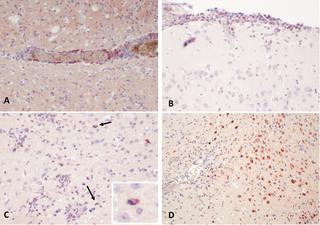当前位置:
X-MOL 学术
›
PLOS Negl. Trop. Dis.
›
论文详情
Our official English website, www.x-mol.net, welcomes your
feedback! (Note: you will need to create a separate account there.)
NS4/5 mutations enhance flavivirus Bamaga virus infectivity and pathogenicity in vitro and in vivo.
PLOS Neglected Tropical Diseases ( IF 3.4 ) Pub Date : 2020-03-23 , DOI: 10.1371/journal.pntd.0008166 Agathe M G Colmant 1 , Helle Bielefeldt-Ohmann 1, 2 , Laura J Vet 1 , Caitlin A O'Brien 1 , Richard A Bowen 3 , Airn E Hartwig 3 , Steven Davis 4 , Thisun B H Piyasena 1 , Gervais Habarugira 1, 2 , Jessica J Harrison 1 , Jody Hobson-Peters 1 , Roy A Hall 1
PLOS Neglected Tropical Diseases ( IF 3.4 ) Pub Date : 2020-03-23 , DOI: 10.1371/journal.pntd.0008166 Agathe M G Colmant 1 , Helle Bielefeldt-Ohmann 1, 2 , Laura J Vet 1 , Caitlin A O'Brien 1 , Richard A Bowen 3 , Airn E Hartwig 3 , Steven Davis 4 , Thisun B H Piyasena 1 , Gervais Habarugira 1, 2 , Jessica J Harrison 1 , Jody Hobson-Peters 1 , Roy A Hall 1
Affiliation

|
Flaviviruses such as yellow fever, dengue or Zika viruses are responsible for significant human and veterinary diseases worldwide. These viruses contain an RNA genome, prone to mutations, which enhances their potential to emerge as pathogens. Bamaga virus (BgV) is a mosquito-borne flavivirus in the yellow fever virus group that we have previously shown to be host-restricted in vertebrates and horizontally transmissible by Culex mosquitoes. Here, we aimed to characterise BgV host-restriction and to investigate the mechanisms involved. We showed that BgV could not replicate in a wide range of vertebrate cell lines and animal species. We determined that the mechanisms involved in BgV host-restriction were independent of the type-1 interferon response and RNAse L activity. Using a BgV infectious clone and two chimeric viruses generated as hybrids between BgV and West Nile virus, we demonstrated that BgV host-restriction occurred post-cell entry. Notably, BgV host-restriction was shown to be temperature-dependent, as BgV replicated in all vertebrate cell lines at 34°C but only in a subset at 37°C. Serial passaging of BgV in Vero cells resulted in adaptive mutants capable of efficient replication at 37°C. The identified mutations resulted in amino acid substitutions in NS4A-S124F, NS4B-N244K and NS5-G2C, all occurring close to a viral protease cleavage site (NS4A/2K and NS4B/NS5). These mutations were reverse engineered into infectious clones of BgV, which revealed that NS4B-N244K and NS5-G2C were sufficient to restore BgV replication in vertebrate cells at 37°C, while NS4A-S124F further increased replication efficiency. When these mutant viruses were injected into immunocompetent mice, alongside BgV and West Nile virus chimeras, infection and neurovirulence were enhanced as determined by clinical scores, seroconversion, micro-neutralisation, viremia, histopathology and immunohistochemistry, confirming the involvement of these residues in the attenuation of BgV. Our studies identify a new mechanism of host-restriction and attenuation of a mosquito-borne flavivirus.
中文翻译:

NS4 / 5突变增强了黄病毒Bamaga病毒在体外和体内的感染性和致病性。
黄病毒,登革热或寨卡病毒等黄病毒是导致全球范围内重大人类和兽医疾病的原因。这些病毒包含易于突变的RNA基因组,从而增强了它们作为病原体出现的可能性。Bamaga病毒(BgV)是黄热病病毒群中的一种蚊子传播的黄病毒,我们先前已证明它在脊椎动物中受到宿主限制,可被库蚊(Culex)蚊子水平传播。在这里,我们旨在表征BgV宿主限制并研究涉及的机制。我们表明,BgV不能在多种脊椎动物细胞系和动物物种中复制。我们确定参与BgV宿主限制的机制独立于1型干扰素反应和RNAse L活性。使用BgV感染性克隆和两种嵌合病毒作为BgV和西尼罗河病毒之间的杂种生成,我们证明BgV宿主限制发生在细胞进入后。值得注意的是,BgV宿主限制被证明是温度依赖性的,因为BgV在所有脊椎动物细胞系中在34°C复制,但仅在37°C的一个亚群中复制。BgV在Vero细胞中的连续传代产生了能够在37°C有效复制的适应性突变体。鉴定出的突变导致NS4A-S124F,NS4B-N244K和NS5-G2C中的氨基酸置换,它们均发生在病毒蛋白酶切割位点附近(NS4A / 2K和NS4B / NS5)。这些突变被反向工程化为BgV的感染性克隆,这表明NS4B-N244K和NS5-G2C足以在37°C的脊椎动物细胞中恢复BgV复制,NS4A-S124F进一步提高了复制效率。当将这些突变病毒与BgV和西尼罗河病毒嵌合体一起注射入具有免疫能力的小鼠中后,通过临床评分,血清转化,微中和,病毒血症,组织病理学和免疫组化确定了感染和神经毒力,从而证实了这些残基参与了减毒BgV。我们的研究确定了一种新的宿主限制和减毒蚊媒黄病毒的新机制。证实这些残基参与了BgV的衰减。我们的研究确定了一种新的宿主限制和减毒蚊媒黄病毒的新机制。证实这些残基参与了BgV的衰减。我们的研究确定了一种新的宿主限制和减毒蚊媒黄病毒的新机制。
更新日期:2020-03-24
中文翻译:

NS4 / 5突变增强了黄病毒Bamaga病毒在体外和体内的感染性和致病性。
黄病毒,登革热或寨卡病毒等黄病毒是导致全球范围内重大人类和兽医疾病的原因。这些病毒包含易于突变的RNA基因组,从而增强了它们作为病原体出现的可能性。Bamaga病毒(BgV)是黄热病病毒群中的一种蚊子传播的黄病毒,我们先前已证明它在脊椎动物中受到宿主限制,可被库蚊(Culex)蚊子水平传播。在这里,我们旨在表征BgV宿主限制并研究涉及的机制。我们表明,BgV不能在多种脊椎动物细胞系和动物物种中复制。我们确定参与BgV宿主限制的机制独立于1型干扰素反应和RNAse L活性。使用BgV感染性克隆和两种嵌合病毒作为BgV和西尼罗河病毒之间的杂种生成,我们证明BgV宿主限制发生在细胞进入后。值得注意的是,BgV宿主限制被证明是温度依赖性的,因为BgV在所有脊椎动物细胞系中在34°C复制,但仅在37°C的一个亚群中复制。BgV在Vero细胞中的连续传代产生了能够在37°C有效复制的适应性突变体。鉴定出的突变导致NS4A-S124F,NS4B-N244K和NS5-G2C中的氨基酸置换,它们均发生在病毒蛋白酶切割位点附近(NS4A / 2K和NS4B / NS5)。这些突变被反向工程化为BgV的感染性克隆,这表明NS4B-N244K和NS5-G2C足以在37°C的脊椎动物细胞中恢复BgV复制,NS4A-S124F进一步提高了复制效率。当将这些突变病毒与BgV和西尼罗河病毒嵌合体一起注射入具有免疫能力的小鼠中后,通过临床评分,血清转化,微中和,病毒血症,组织病理学和免疫组化确定了感染和神经毒力,从而证实了这些残基参与了减毒BgV。我们的研究确定了一种新的宿主限制和减毒蚊媒黄病毒的新机制。证实这些残基参与了BgV的衰减。我们的研究确定了一种新的宿主限制和减毒蚊媒黄病毒的新机制。证实这些残基参与了BgV的衰减。我们的研究确定了一种新的宿主限制和减毒蚊媒黄病毒的新机制。











































 京公网安备 11010802027423号
京公网安备 11010802027423号